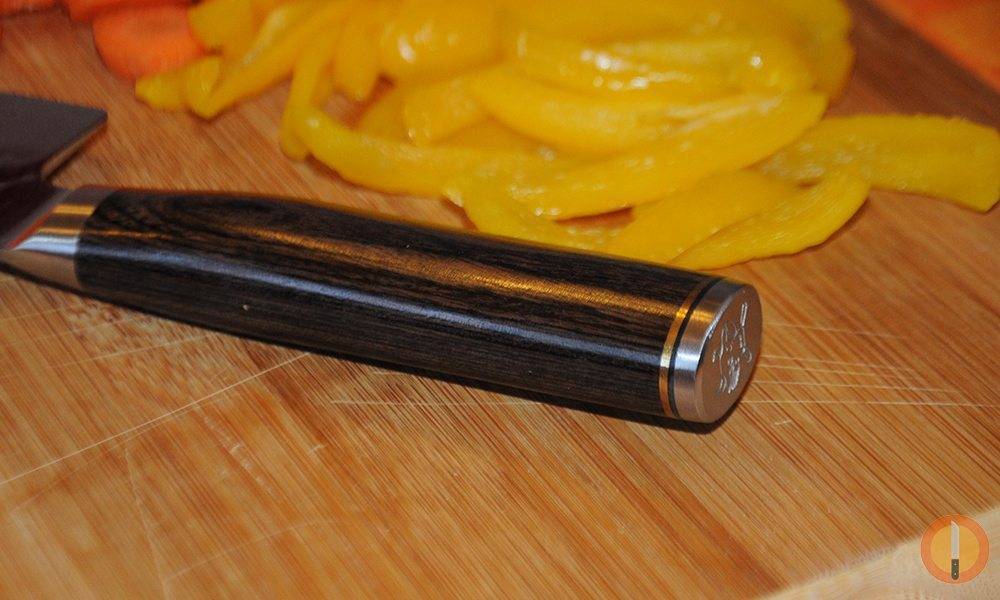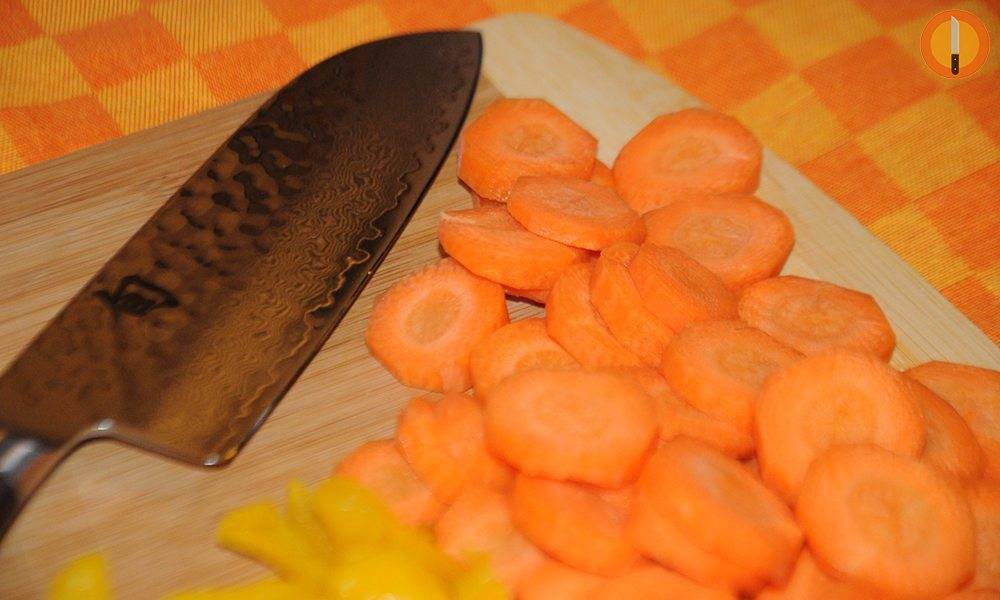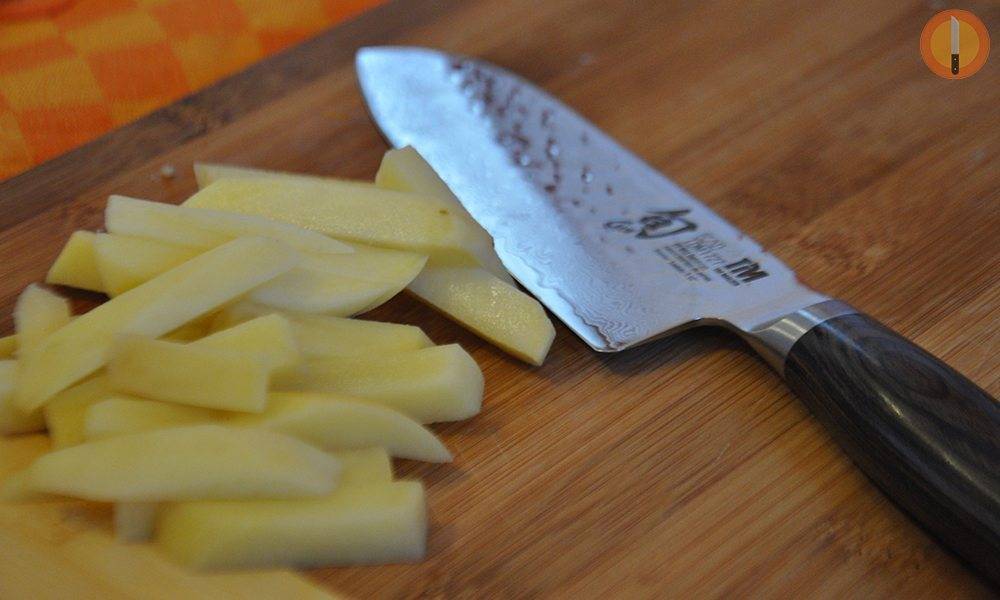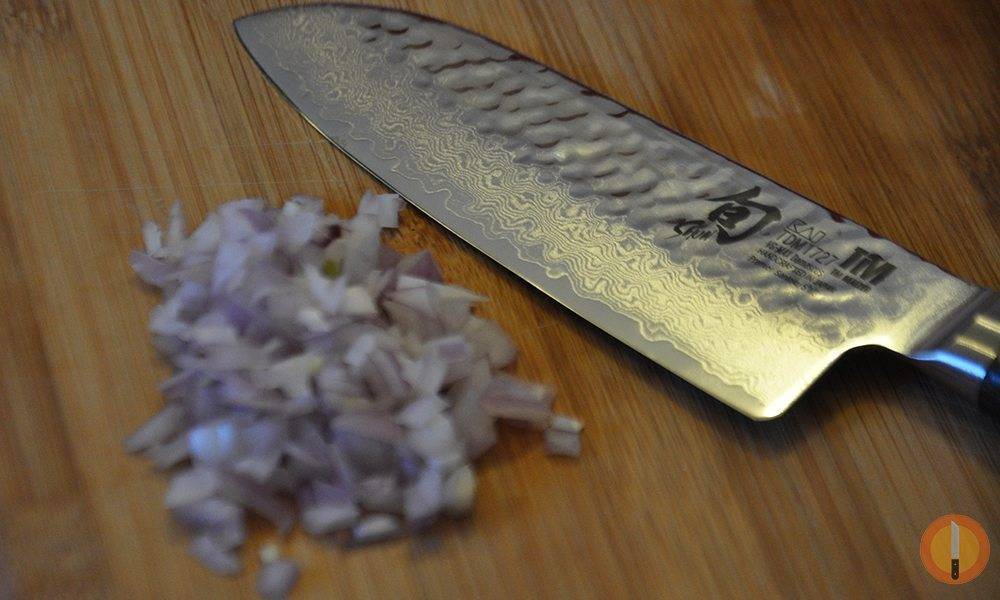JAPANESE KITCHEN KNIVES
The Best Santoku Knives: A Cook’s Buying Guide
30.08.2015
Every well-stocked kitchen has at least one santoku knife. Designed for general-purpose, I use my santoku for most kitchen prep work, including mincing, slicing and dicing. Even if you’ve never heard of its name, there’s a good chance you’re already familiar with and well-accustomed to this knife. Its design is very similar to the Western chef’s knife. I’ve tried many knives in my career as a Chef: keep reading, let me show you my favorite Santoku.
OUR COMPARISON CHART: THE TOP SANTOKU KNIVES
[table id=8 /]
THE BEST SANTOKU KNIFE: SHUN PREMIER 7-INCH

If you’re looking for the perfect Santoku knife, look no further. I’ve been using many Santoku knives, both professionally and at home, and my go-to choice is the Shun Premier 7-inch. I use it for so many different tasks in the kitchen. It’s great for chopping, dicing and slicing. All in all, a perfect knife for vegetables. I also use it to cut boneless meat. It comes with a super sharp edge right out of the box, it holds it for a long time and it’s very easy to maintain.
[easyazon_link identifier=”B003B66YK0″ locale=”US” tag=”knifepla-20″]> Check out the Shun Premier on Amazon <[/easyazon_link]

Shun is one of the most famous names in the knife industry. The Shun 7” santoku is made in Japan, and is forged with Damascus steel. It also features a Tsuchime finish that reduces drag when cutting and prevents food from sticking to the blade. The pakkawood handle is the icing on the cake. Not only does the handle look great, but it’s contoured to fit perfectly in the palm of your hand.

The Shun looks great, is comfortable to work with and features a razor sharp edge. If you’re looking for a top-notch Santoku, you must have this knife in your kitchen.
KnifePlanet’s Exclusive Video Review of the Shun…
![]()
[easyazon_link identifier=”B003B66YK0″ locale=”US” tag=”knifepla-20″]> Buy The Shun Premier on Amazon <[/easyazon_link]
WHAT ARE THE BENEFITS OF SANTOKU KNIVES?
Why do I love my Santoku knives so much? For starters, they’re versatile. I can use them for just about any prep work, whether I need thin slices of radish for garnish or minced garlic for a stir-fry. These knives offer numerous other benefits as well, including:
- Because they’re lighter, santoku knives allow for quicker cutting and less strain when compared to other heavier knives.
- No “rocking”. Some people are a fan of the “rocking” motion, but straight chopping – in one motion – is often quicker. With a santoku, “rocking” is limited, and thin slices are achieved through a single, quick chopping motion.
- Useful for any job. Whether you’re working with vegetables, fish or boneless meat, the santoku can tackle just about anything.
- Santoku knives have thin blades, which means the blade needs to be made of durable, hard steel. Provided you take proper care of your knife, it will provide you with years of use.
- Easy to work with. Because it’s lightweight and its blade is thin, santoku knives are easy to work with. If larger and heavier knives, like the cleaver, are hard for you to work with, the santoku knife is an excellent alternative.
Its versatility, light weight and ease of use make the santoku knife a must-have for any kitchen.
WHAT MAKES SANTOKU KNIVES UNIQUE?

What makes a santoku knife so special? First, let’s look at its design.
The santoku has what’s called a “sheepsfoot” blade, and like its name suggests, the blade’s shape resembles a sheep’s hoof. Its edge is curved, but the curve isn’t quite as dramatic as the German chef’s knife. It’s the slight curve of the santoku blade that makes this knife unique and easy to work with.
Rather than relying on a rocking motion, the santoku uses more of a slight forward motion and a vertical chop. While there is a bit of a learning curve when using this knife, once you get the hang of it, you’ll notice that you have much more control over the knife and the thickness of the cut.
Santoku knives are only able to achieve this motion because the blade is made of hard steel and is much thinner than its Western counterpart.
The blade is also wider, which makes it great for scooping up things. If I’m chopping a red pepper for a salad, I can quickly scoop up the pepper with the edge and toss it into the bowl –without scraping the cutting board.
In many ways, the santoku knife offers the same functionality and versatility as a typical Western chef’s knife, but comes with the added bonus of being lighter in weight and shorter in blade size. If you find that a typical 8-10” chef’s knife is just too big and difficult to handle, a santoku is an excellent choice.
WHAT TO LOOK FOR IN A SANTOKU KNIFE

There are a couple of things I recommend looking for when buying a santoku knife, including:
Blade material. The very first thing you should look at is the blade material. Today’s knives are typically made of one of four materials: carbon steel, high carbon steel, ceramic and stainless steel.
- High carbon steel is the preferred choice if you’re looking to invest in a high quality knife. This type of steel is not only rust and stain resistant, but durable as well. These blades tend to hold their edge for much longer and can be sharpened easily.
- Carbon steel is easy to sharpen and less expensive than high carbon steel. These blades do hold a nice sharp edge, but can fall victim to staining and rusting over time.
- Stainless steel is a common material and a budget-friendly choice. While it won’t hold its edge as long as high carbon steel, this material is resistant to rust, corrosion and staining.
- Ceramic knives require virtually no maintenance, and tend to be lightweight. These blades are extremely hard and can also hold their edge for years. The biggest issue with ceramic is that the blade is fragile, so you can only use it with a cutting board.
If you have the budget, opt for high carbon steel. These knives retain their edges for a very long time, and are a breeze to sharpen. If you’re on a tighter budget, stainless steel is a smart choice.
Handle composition. A knife’s handle may seem trivial, but it actually makes a major difference in how the knife feels in your hand. Control, balance and safety all rest on the composition of the knife’s handle. So, what should you be looking for? There are a few different materials used for handles.
- Stainless steel – Arguably the most durable and sanitary option. That being said, these handles generally add a lot of weight to the knife and can make it feel off-balance. Stainless steel can also become very slippery when wet. If you’re considering this material for your handle, look for knives that have ridges or indentations for a more secure grip.
- Plastic – A budget-friendly option. Plastic handles are non-absorbent and very easy to care for, but they’re also slippery and too lightweight.
- Wood – Arguably the best-looking handle. Wood handles offer an excellent grip, but they do require some extra maintenance. Over time, these handles can warp or crack if exposed to water regularly or improperly cared for.
- Composite – A combination of plastic resin and wood composites. Composite handles are considered the best by chefs. They’re easy to care for and offer a secure grip.
Handle and blade composition are the two most important things to consider when shopping for a santoku knife.
A CHEAPER OPTION: THE WUSTHOF SANTOKU

Practically any knife from the Wusthof brand is an excellent choice, and their 7” santoku is no exception. Even though I prefer the Shun Premier, the Wusthof is still a great and durable Santoku knife.
I love this knife because it can create paper-thin slices. It’s forged with high carbon stainless steel from Germany, and the double bolsters provide balance and heft. This knife also has a full tang that extends all the way through the handle.
The handle is triple-riveted, black and contoured for a sleek look and a secure, comfortable grip.
All Wusthof knives are backed by a lifetime warranty, so you can feel good about buying this knife.
[easyazon_link identifier=”B000WW45NY” locale=”US” tag=”knifepla-20″]> Buy The Wusthof Santoku on Amazon <[/easyazon_link]
IT’S DECISION TIME
Now that we’ve helped you understand what the benefits of Santoku knives are, it’s your turn to choose what the right model is for you. If you’ve got the chance, test the knife before buying it, feel it in your hand, and maybe slice some vegetables with it.









